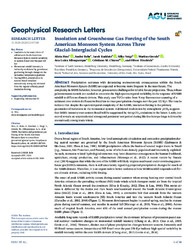Insolation and Greenhouse Gas Forcing of the South American Monsoon System Across Three Glacial-Interglacial Cycles
DOI: https://doi.org/10.1029/2020GL087948
Persistent URL: http://resolver.sub.uni-goettingen.de/purl?gldocs-11858/9324
Persistent URL: http://resolver.sub.uni-goettingen.de/purl?gldocs-11858/9324
Hou, Alicia; Bahr, André; Raddatz, Jacek; Voigt, Silke; Greule, Markus; Albuquerque, Ana Luiza; Chiessi, Cristiano M.; Friedrich, Oliver, 2020: Insolation and Greenhouse Gas Forcing of the South American Monsoon System Across Three Glacial-Interglacial Cycles. In: Geophysical Research Letters, Band 47, 14, DOI: 10.1029/2020GL087948.
 |
Dokument öffnen: |
Precipitation extremes with devastating socioeconomic consequences within the South American Monsoon System (SAMS) are expected to become more frequent in the near future. The complexity in SAMS behavior, however, poses severe challenges for reliable future projections. Thus, robust paleomonsoon records are needed to constrain the high spatiotemporal variability in the response of SAMS rainfall to different climatic drivers. This study uses Ti/Ca ratios from X-ray fluorescence scanning of a sediment core retrieved off eastern Brazilian to trace precipitation changes over the past 322 Kyr. The results indicate that despite the spatiotemporal complexity of the SAMS, insolation forcing is the primary pacemaker of variations in the monsoonal system. Additional modulation by atmospheric pCO2 suggests that SAMS intensity over eastern Brazil will be suppressed by rising CO2 emissions in the future. Lastly, our record reveals an unprecedented strong and persistent wet period during Marine Isotope Stage 6 driven by anomalously strong trade winds.
Statistik:
ZugriffsstatistikSammlung:
This is an open access article under the terms of the Creative Commons Attribution License, which permits use, distribution and reproduction in any medium, provided the original work is properly cited.

